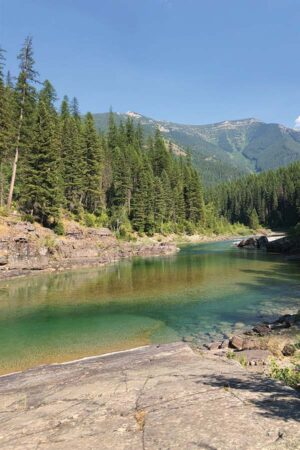Protect the Wild and Scenic Forks of the Flathead River
The Wild and Scenic Forks of the Flathead River provide a stronghold for native trout, quality habitat for sensitive wildlife species like mountain goats, grizzly bears, and moose, as well as world-class river recreation opportunities. However, dramatic growth in recreational use in recent years is straining the river, the ecosystem it supports, and the recreational experience for many people.
On January 6th, the Flathead National Forest finally re-launched the stalled development of a new Comprehensive River Management Plan for the Wild and Scenic Flathead that is intended to better safeguard the river corridor while improving river recreation management. Now is your opportunity to provide input on several critical parts of the proposed plan (a full draft has not been completed or released).
Although there are some good components, the proposed actions still fall short of what is needed to truly protect the river system and the fish and wildlife that depend on it from the impacts of ever increasing recreational use. Please submit comments to help the Forest Service improve the plan!

Submit Written Comments
The Forest Service has asked for feedback on the desired conditions, user capacity, and proposed management actions included in the Proposed Action. See our suggested comments. Comments are due Friday, February 7th, 2025.
Comments may be submitted electronically on the Forest Service website.
Mail or hand deliver comments to either:
Chris Prew, Recreation Program Manager
Flathead National Forest Supervisor’s Office
650 Wolfpack Way
Kalispell, MT 59901
Or,
Chris Prew, Recreation Program Manager
Hungry Horse-Glacier View Ranger District
PO Box 190340
10 Hungry Horse Dr
Hungry Horse, MT 59919
Thank you for helping to protect the Wild and Scenic Flathead River!
For questions or information about the Forest Service’s proposal, please contact Chris Prew at 406-758-5322 or christopher.prew@usda.gov.
For questions or information about our view on the proposed plan, please contact Peter Metcalf, Executive Director, at peter@ glacierwomedicine.org.
Please submit comments to help the Forest Service improve their Comprehensive River Management Plan!
Suggested Comments
We suggest you provide the following points as part of your comments. For greatest effectiveness, personalize your comments and confine them to the proposed action:
- Support the proposed establishment of a mandatory permit system for all floaters - The Forest Service lacks solid data on how many people use the river and for what purposes. Consequently, their proposed user capacity numbers are educated guesses and negotiated compromises between experts, rather than based on actual use data and associated impacts. The proposed free, unlimited permit system would provide the Forest Service crucial user data to better inform effective management action.
- Support the proposed extended no-stopping order and prohibition on dogs around the Goat Lick - Extending the current no-stopping order to prohibit floaters from stopping between Staircase Rapid and Split Rock Rapid will reduce disturbance to mountain goats, as well the prohibition on dogs in this area. Monitoring indicates mountain goats use a wider stretch of the river here than previously known. This is the only area mountain goats consistently access and cross the Middle Fork of the Flathead River. Minimizing disturbance is crucial to goat conservation in both Glacier National Park and the Bob Marshall Wilderness complex.
- Additional monitoring provisions for wildlife trends and recreational impacts to wildlife are needed - Inexplicably, the plan contains almost no provisions to monitor wildlife trends in the corridor except for mountain goats. Monitoring should, at a minimum, record where wildlife commonly cross the the Middle Fork between the Bear Creek River Access site and West Glacier – as this would help inform the siting of future wildlife crossing structures on the highway and / or railway as well as other actions to improve wildlife connectivity – and whether recreational river use is harming or displacing certain species like bears or moose.
- The Forest Service should identify and evaluate potential strategies to limit recreational use while developing the plan – Limiting recreational use in certain stretches of river may be necessary now, or in the future, to protect fish and wildlife, other outstandingly remarkable values, or the recreational experience. In developing the plan, the Forest Service should identify and evaluate a range of different strategies by which it may limit recreational use, should monitoring indicate such limits are necessary. This will help the agency better understand their public acceptability of different strategies, as well as be better prepared to quickly adapt management to improve resource conditions without having to first initiate a new time intensive, full environmental review for certain actions.
- An equitable portion of priority use service days should be allocated to non-commercial outfitters who provide affordable, education-focused trips or who serve underrepresented demographics, like Indigenous communities, veterans, youth, or people with disabilities – The proposed allocation at present would allow massive growth (from 35,713 authorized user days to 136,000 authorized user days on the Middle Fork below Bear Creek alone) for the four existing commercial outfitters, all of whom offer the same basic service – single or multi-day whitewater rafting or fly fishing trips – primarily to tourists. One measly, temporary permit for only 50 user days (yes, five zero) would be reserved for an educational program or provider for underserved communities. This inequitable allocation ratio is a totally unacceptable commercialization of the public’s river and needs to be better balanced.
Read the comments submitted by GTMA here.
Background
In 1976, Congress designated 219 miles of the Flathead River, including the entire Middle Fork, North Fork and South Fork above Hungry Horse Reservoir, as a Wild and Scenic River under the Wild and Scenic Rivers Act. The Act, which passed in 1968, was largely inspired by the Middle Fork’s thrilling whitewater and scenery (a dam was proposed at Spruce Park), and intended to save some of America’s last remaining free-flowing rivers from inundation. A Wild and Scenic designation protects a river's free-flowing condition (i.e. no new dams or diversions), water quality, and what the Act calls “outstandingly remarkable values,” or ORVs. The Flathead River’s ORVs include its native fisheries, rare wildlife like goats and grizzly bears, incredible scenery, unique geology, world-class recreation, and important historical and cultural resources, including past and present connections and use by Indigenous people.
The Forest Service was designated as the primary authority responsible for managing the Wild and Scenic Flathead to protect these values, with cooperation from Glacier National Park and the state of Montana. The current management plan was written in 1980, with updates in 1986. An update is sorely needed to address changes in levels and type of use, resource conditions, and management directives.
In 2017, the Flathead National Forest, in collaboration with Glacier National Park, initiated the development of a new, Comprehensive River Management Plan. Public meetings and a formal comment period occurred in 2018 and 2019 respectively. However, the process stalled out due in part to Covid and lack of capacity, before a draft plan was completed. The Forest Service secured additional capacity this past year to restart the process, with a goal of completing the plan in two years. The current comment period on a portion of the proposed plan is the next step in the process. A complete draft plan is anticipated to be released for public review in August.
Learn more about the Wild and Scenic Rivers Act, our nation’s foremost river protection law, and the National Wild and Scenic Rivers System the law.
We’ll provide more information and perspective after the public meetings.
Sign up for our mailing list to stay informed about this project.
Thank you for taking time to comment. Your comments will help better protect these rivers' free-flowing characteristics, water quality, and outstanding ecological, cultural, scenic, and recreational values.
Questions? Want more information? Please email Peter Metcalf at peter@glaciertwomedicine.org
